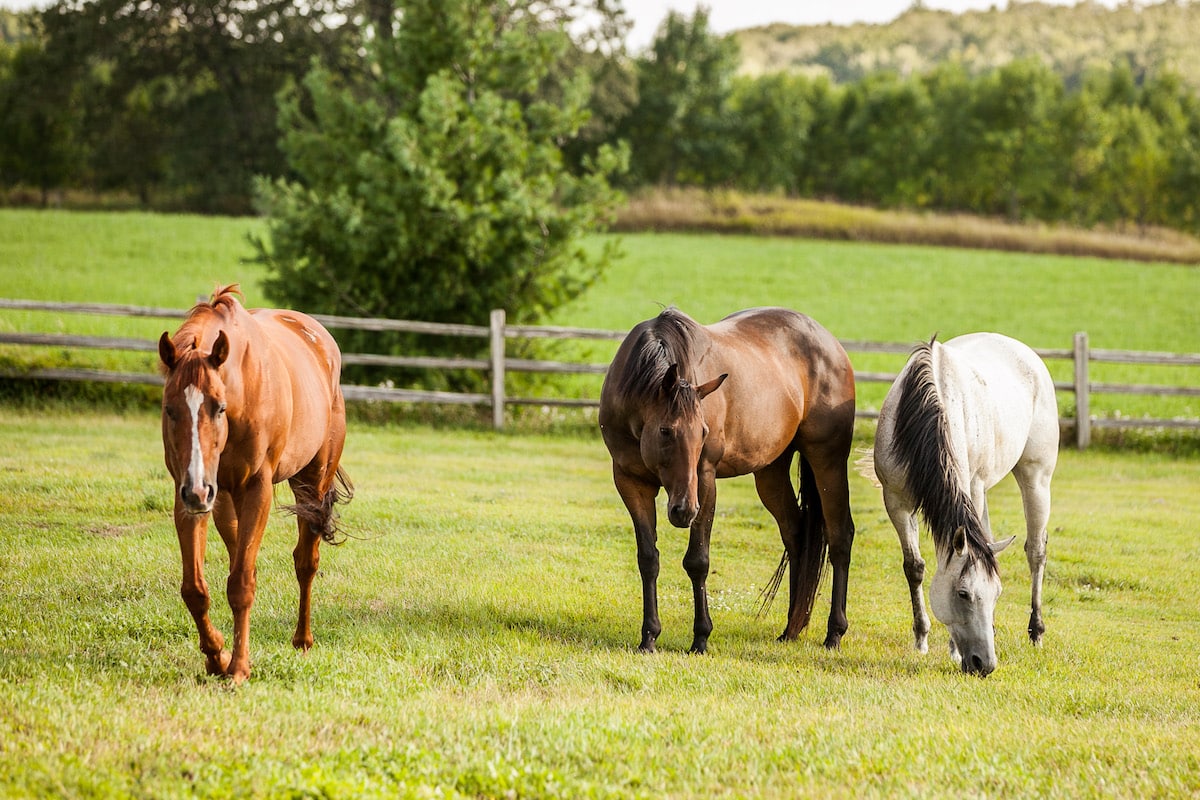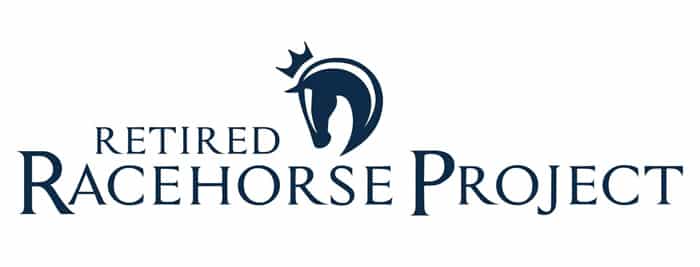Tips for preventing colic during the retirement, retraining and rehoming processes

Note that OTTBs with newfound access to turnout in a herd setting have increased exposure to internal parasites. Start a targeted program to reduce the colic risk associated with parasite infections. Courtesy istock.com
A horse’s gastrointestinal tract — the intestinal microbiome in particular — is exquisitely delicate and does not like surprises. Any change in management can cause stress, which in turn can trigger colic — a general term used to describe abdominal pain in horses. When considering the life of a racehorse, essentially every aspect of his or her management changes once retired and rehomed. In this article we’ll cover the important features of a colic prevention plan to start your ex-racehorse off on the right hoof.
General Recommendations
Certain types of colic are “intestinal accidents” — events we might not be able to prevent. Others, however, are diet- and management-related, and we can take steps to minimize their occurrence. These tips for preventing colic apply to nearly every horse:
■ Establish and maintain a daily routine, including feeding and exercise schedules.
■ Feed a high-quality diet composed primarily of roughage (hay and grass), avoiding excessive grain and energy-dense supplements.
■ Avoid feeding large meals. Instead, divide daily concentrate rations into two or more smaller feedings to avoid overloading the horse’s digestive tract. Ensure horses have access to forage throughout the day.
■ Set up (and follow!) a targeted parasite control program.
■ Provide fresh, clean water at all times.
■ Minimize stress. This includes stress from performance/competition, transport and changes in routine, turnout, herdmates, etc.
Ultimately, each of these recommendations supports a healthy intestinal microbiome — the collection of microorganisms residing in the cecum and large intestine. Anything that stresses the intestinal microbiome stresses the horse, easily manifesting as colic.
Life on the Backside
Horses on the track have highly structured schedules and consume high-quality feeds, both of which minimize their chances of colic. On the flip side, racehorses training and competing at an elite level are under a great deal of stress and fed in ways that might contribute to colic.
Importantly, racehorses need concentrated feeds to meet the high energy (calorie) demands of their job. For many racehorses those concentrates are offered in a limited number of large meals throughout the day — a management factor known to contribute to colic.
“Depending on the level of work, most racehorses eat between 4 and 7 kilograms (8.8-15.4 pounds) of grain per day,” says Stephen Duren, PhD, an equine nutritionist with Performance Horse Nutrition, in Weiser, Idaho. “Meal feeding is common, with many racehorses being fed twice or three times daily. Only some of the progressive trainers feed four times per day.”
To pack in even more calories, trainers commonly add oil — a high-calorie supplement — to their charges’ diets.
“The majority of oil is added into the feed at the time of manufacturing, with most ‘race’ feeds having between 6 and 10% fat,” Duren says. “Some trainers will also top-dress oil at an additional rate of 100 to 200 milliliters (about 3.4-6.8 fluid ounces)/horse/day. If the grain concentrate does not contain much added fat, the amount of top-dressed oil can be increased to 400 milliliters/horse/day.”
The limited turnout, minimal direct physical access to other horses and stresses associated with any physical ailments (e.g., musculoskeletal injuries, gastric ulcers), as well as transport to and from tracks can also negatively affect the gastrointestinal tract/intestinal microbiome, creating a perfect storm for dysbiosis — a microbiome imbalance — and colic.
Life Upon Retirement
Whether a racehorse’s retirement is abrupt or planned, he or she inevitably experiences sweeping management changes. However, the amount of concentrates in an off-track Thoroughbred’s diet does not initially decrease dramatically, says Duren.
“Retired racehorses have high energy requirements for months following the conclusion of racing,” he explains. “Some racehorses are underweight and/or have injuries that are catabolic in nature, meaning they still need energy/calories to repair the injured tissues.”
The major dietary change that occurs when a horse transitions from the track to an adoption program, reseller or sport horse barn is he’ll no longer eat grain or concentrates designed for racehorses, Duren says. The concentrates portion of the diet will be switched to a nonracing feed.
He notes that in addition to the changes in type, quantity and frequency of feeding, the form of the concentrate might change from a textured to a pelleted one.
While altering the energy content or texture of the concentrate might not seem significant to us, the horse’s intestinal microbiome might protest.
“It takes about 21 days for the horse’s intestinal tract, the intestinal microbiome specifically, to adapt to any change in diet,” says Duren.
Another key management change is pasture turnout, which most racehorses do not have during their training and racing careers.
“The introduction of high-quality pasture is beneficial for ulcer healing (almost 100% of racehorses have gastric ulcers) and weight gain,” explains Duren.
Life After Rehoming
When you bring your new OTTB home, diet and management changes again ensue.
If your horse is underweight or still looks like a lean, mean racing machine, you can’t eliminate the grain concentrates from his diet just yet. Rather, split up those concentrates into at least three meals a day. You can also modify the type of concentrate you feed, changing the ratio of ingredients in the mix. Duren recommends including less grain and more super fiber (e.g., beet pulp, soy hulls) and a minimum of 8% fat.
Once your horse reaches a body condition score of 5 or 6 out of 9, then you might be able to gradually reduce or even eliminate grain and high-concentrate supplements.
“My standard approach when transitioning racehorses is to utilize large amounts of high-quality forage,” Duren says. “This includes free-choice grass hay as well as some alfalfa to provide extra calories and protein. The quality of pasture is also critical. ”
Even if your horse’s gastric ulcers have healed post-retirement from racing, he might be at risk for recurrence. Stress associated with a new environment, owner/handler, diet and feeding schedule, as well as establishing social interactions with new herdmates, can all contribute to ulcer resurgence.
Don’t forget to consider all aspects of your horse’s diet. Surveys of horse owners reveal they love supplements. Joint, hoof, coat and calming supplements are among the most popular and certainly can have a place in an OTTB’s life. Again, any oral supplement or medication can alter the intestinal microbiome, potentially contributing to colic. Make one change in supplementation, medication or diet at a time, allowing the microbiome a few weeks to adapt.
Also consider how you plan to control internal parasites. While internal parasites aren’t major concerns in racehorses (since transmission primarily occurs on pasture), OTTBs with newfound access to turnout in a herd setting have increased exposure to parasites such as roundworms, tapeworms and small strongyles. Given the increasing resistance of internal parasites to available chemical dewormers, base your parasite control program on fecal egg counts performed by your vet to ensure it’s effective.
The Keys to Colic-Free Aftercare
Duren offers takeaways for preventing colic in your recently retired racehorse: “I try to keep it simple and use my money buying the best hay I can find,” he says.
When needed, provide your horse with a grain concentrate containing high fat and fiber content. This supplies the necessary energy while lowering the risk of colic-inducing carbohydrate overload, he says.
Finally, targeted parasite control, free access to fresh water and minimizing stress help round out the best possible colic prevention protocol.


